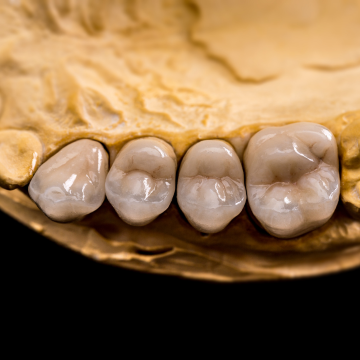A dental crown is a cap-shaped restoration designed to cover a damaged or decayed tooth. It restores the tooth’s shape, size, strength, and appearance, allowing it to function properly. Crowns are often recommended when a tooth is severely damaged or decayed and cannot be repaired with a simple filling.
-
Metal Crowns: Made from alloys such as gold, platinum, or other metals, these crowns are known for their durability and strength, making them ideal for molars or teeth at the back of the mouth. While highly functional, they are more visible and less aesthetic than other types.
-
Porcelain-Fused-to-Metal Crowns (PFM): These crowns have a metal base with a porcelain exterior that mimics the natural color of teeth. They combine strength with a more aesthetic appearance and are commonly used for both front and back teeth.
-
All-Ceramic or All-Porcelain Crowns: These are the most aesthetic crowns, offering a natural look as they can closely match the color of the natural tooth. They are especially popular for front teeth. Although they are less durable than metal or PFM crowns, they are ideal for people with metal allergies.
-
Resin Crowns: Made from composite resin, these crowns are less expensive but not as durable or long-lasting as porcelain or metal crowns. They are typically used in situations where cost is a primary concern.
-
Zirconia Crowns: Known for their strength, zirconia crowns offer a good balance between durability and aesthetics. They are ideal for patients who need a crown that is both functional and natural-looking.
-
To Protect a Weak Tooth: If a tooth is cracked or worn down, a crown can protect it from further damage.
-
To Restore a Broken Tooth: Crowns are often used to restore a tooth that is severely worn or broken, giving it a more natural form and function.
-
To Cover a Tooth with a Large Filling: When a large filling is needed, a crown can help restore the tooth’s integrity and protect it from breaking.
-
To Improve Appearance: Crowns are often used to improve the appearance of a tooth that is discolored, misshapen, or otherwise aesthetically compromised.
-
After Root Canal Therapy: Teeth that have undergone a root canal are more fragile and prone to breaking. A crown is used to protect and strengthen the tooth after treatment.
-
Initial Consultation and Examination: The dentist will take X-rays and examine the tooth to determine if a crown is necessary. If the tooth has significant decay or damage, a root canal may be performed first.
-
Tooth Preparation: The tooth is reshaped by removing part of the enamel to make room for the crown. This ensures the crown fits properly and does not affect the bite.
-
Impressions and Temporary Crown: After the tooth is shaped, an impression is taken to create a custom crown. A temporary crown is placed on the tooth to protect it while the permanent crown is being made, typically taking a few weeks.
-
Crown Placement: Once the permanent crown is ready, the temporary crown is removed, and the permanent one is fitted and bonded in place. The dentist will check the fit and make any necessary adjustments to ensure the crown fits comfortably and aligns with your bite.
Dental crowns are an effective way to restore damaged teeth, enhancing both their function and appearance. Your dentist can help you choose the best type of crown for your individual needs.
Sign up for an appointment
It just takes a few minutes to sign up and get fast, easy access to care, 24/7. No need for your insurance card yet.

